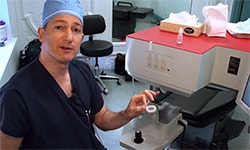Editorially Independent Content
IntraLase-enabled Keratoplasty uses the iFS advanced femtosecond laser (AMO) to create innovative-shaped corneal incisions for full-thickness corneal transplants.
As a Cornea, Cataract and Refractive Surgeon practicing at Northwest Eye Surgeons, in Seattle, WA, I’ve been using the IntraLase for femtosecond-assisted laser keratoplasty for about eight years now. When I began using this device, there was nothing on the U.S. market capable of doing anything similar, and there still isn’t.
ELEGANT SOLUTION
Once you’ve done femto-assisted keratoplasty, there’s no way you would ever want to use a blade again. It’s so much more elegant, from the wound construction to the visual rehabilitation and the appearance of the corneas afterwards.
About 95% of the keratoplasty I do—not including endothelial keratoplasty, which is different—is femtosecond laser-assisted. It enables faster, stronger wound healing. This means you can put in fewer sutures and remove them sooner for faster visual recovery and rehabilitation, with less astigmatism.
FASTER HEALING
It’s not unusual for patients to have improved vision, and be fitted for glasses, just one month post-op. These results are very different from what I’d previously experienced with traditional keratoplasty techniques.
For wound construction, I use Zigzag C. This is a zigzag wound construction similar to a tongue-and-groove fit, and you can use it for either full thickness or DALK, and it works really nicely.
LEARNING CURVE
There’s a learning curve at first. It’s challenging to decide on things like the correct pattern to use for wound construction and what suturing techniques to use. While patients are fairly comfortable during the docking procedure, you have to make sure they stay still for the two and a half minute laser procedure. This doesn’t sound long but it can be for the patient, and you never want to have a loss of suction. Having said that, I’ve only had two instances of suction loss the entire time I’ve been doing this.
INTEGRATED BED IMPEDES WORKFLOW
I understand the reasons for having a bed integrated with the IntraLase for docking for corneal work. But it’s more cumbersome to move the patient from pre-op to the IntraLase, then to a wheelchair out of the laser room back to their bed, which will then be wheeled into the into the operating room. Having a system that doesn’t have the integrated bed design would allow for better patient comfort and patient flow.
GREAT SOLUTION
I would recommend this technology to a colleague. I would also advise them to visit someone who’s already using it. There are some subtle techniques, just like when you’re starting out with any other new procedure, so it’s helpful to see them in person. Or at least, look at different videos on Eyetube or YouTube or call a colleague. That’s what I did when I first got started because there are some subtleties you’ll pick up. But all in all, it’s a great solution.

